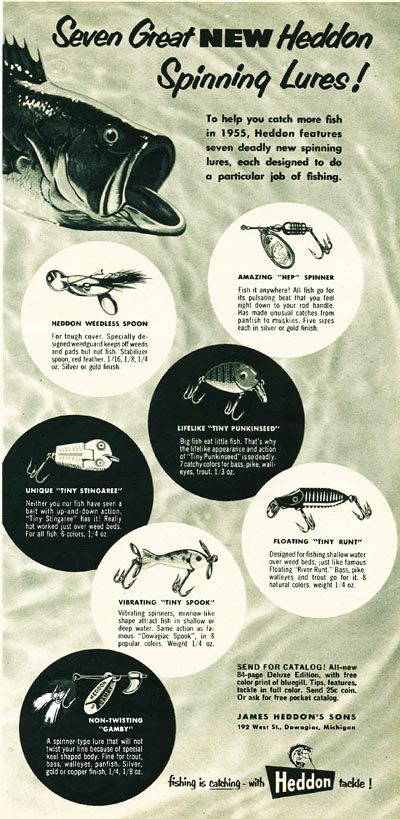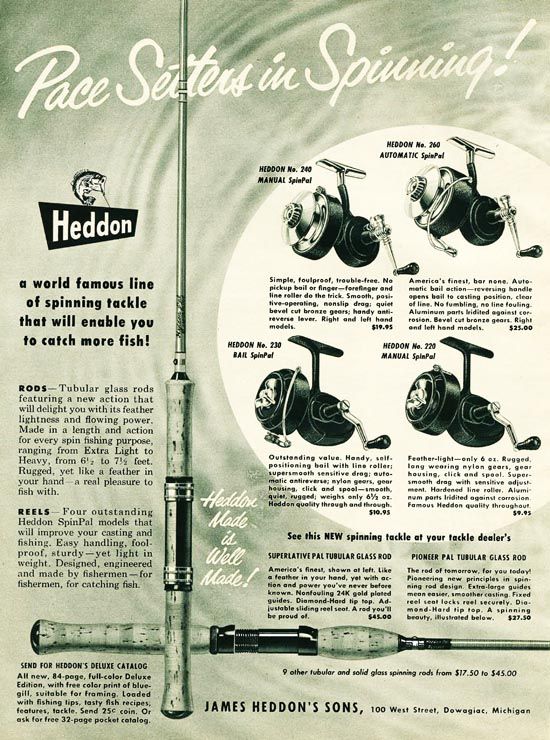The longer I study vintage tackle advertising and fishing articles, the more I have come to appreciate the many changes in fishing methods and tackle that took place in the decade following World War II. The only period in the 20th century that seems to come close to it in tackle development is the economic boom years of the 1920s. This last observation started years ago when I first began to look through old tackle boxes and noticed that baits from the 1920s were far more common than those produced during the Depression years of the 1930s.
After World War II there were many changes in fishing tackle that quickly burst onto the scene. Glass rods, the switch nylon lines, the move toward smaller lures, the change from wood to plastic for the majority of new and many older lures, and the biggest change of all -- the popularization of spinning and the tackle it required.
The first ad below is from the 1951 issue of the Sports Afield Fishing Annual. With the possible exception of the Baby Chugger, the “new” Heddon lures for 1951 are an undistinguished class. Most of them did not set any sales records nor were they long mainstays in the Heddon line. Of the baits shown, only the Flaptail Spook has proved to be a fish catcher for me and then only on Northern Pike. By the way, it is one of those “surface” lures that sinks like a stone if not reeled quickly over the water. 1951 was the year that Heddon introduced the solid glass “Pal Spook” baitcasting rods. When one looks through this ad or the 1951 Heddon Deluxe Catalog there is no mention of spinning; no reels, no rods and no appropriate lures. They seemed to have been caught flat footed by the enormous changes that were beginning to take place.

In 1952 Heddon introduced three lures specifically made for spinning. The Tiny Runt, the Tiny Torpedo and the Tiny Lucky 13. Also in 1952 Heddon offered a solid glass spinning rod as well as a short-lived bamboo spinning rod, but still no spinning reels. By 1953 a hollow glass spinning rod as well as the Heddon “Spin Pal” open faced reel were offered. Looking through 1954 outdoor magazines there appears ad after ad for spinning reels, (many of which did not make the cut and are best forgotten) and relatively few ads for baitcasting tackle. In 1955 the following two ads appeared in the Sports Afield Fishing Annual. They speak for themselves as to the changes at Heddon and the rest of the tackle industry in only four years time.


By 1956 there were at least 13 different spinning rods offered in Heddon's catalog as well as six models of open faced spinning reels and page after page of lures specifically designed for spinning. It was indeed a decade of change and in Heddon's case it all took place in the last five years of that decade after the close of World War II.
Around 1953 my Father and I were riding in a small boat and we passed a young man standing on the end of a dock using an open faced spinning reel. I turned to my father and asked him what kind of reel it was. He allowed as it was probably one of those new “spinning reels” he had heard about. Watching the bail go around, I could not imagine how the reel worked. By 1955 I had purchased an open face spinning reel of long-forgotten parentage and lacking a “spinning rod” I used the reel up side down on an old baitcasting rod. A poor arrangement at best, but I was very proud of my outfit and my new found ability to cast my bait and bobber “way out there.” I recall during this time many local men my father's age who put their baitcasting rods in the garage and swore that never again would they use anything but spinning tackle.
Today I seldom pick up a spinning rod with the exception of an ultralite to fish for panfish. My friends and I enjoy using vintage baitcasting outfits the same way some folks enjoy hunting with a bow or a flintlock. I have a difficult time persuading many, my age and older, to go back and give baitcasting another try. Their memories of that time period are filled with backlashes and frustrations. Spinning has never been more popular.
Tight Lines
Wild Bill Sonnett
No comments:
Post a Comment